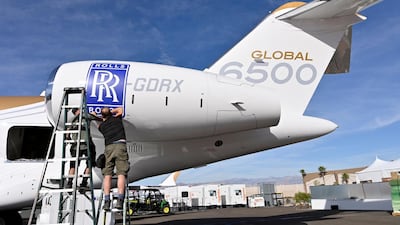Rolls-Royce, which makes engines for planes and ships, plans to achieve net zero emissions by 2050 by ensuring all of its aircraft engines can run on sustainable aviation fuels (SAFs) and by decarbonising all new products.
The British engineering company outlined its green goals on Thursday, pledging that all new products will be compatible with net zero targets by 2030, and that its whole business will be net zero by 2050 at the latest.
In the aviation sector, its biggest business, the company said all of its engines will be able to operate with 100 per cent sustainable aviation fuels by 2023, which produce less carbon than traditional jet fuel.
Warren East, chief executive of Rolls-Royce, said achieving net zero was imperative for its customers and communities and while it presented a big challenge for the company, it also offered commercial opportunities.
“It’s challenging because our customers use our products and services in sectors where demand for power is actually increasing over the next several years. These are the sectors that are among the hardest, to actually get to net zero. So a double challenge", said Mr East.
“Because these sectors are hard to decarbonise our innovation to help our customers succeed and achieve net zero is essential. It's essential now, but when it works, it's also going to enable and even accelerate the overall global transition.”
Mr East said few companies have the same breadth of technologies as Rolls-Royce.
While the energy output from the company’s products and services was approximately 300,000 gigawatt hours at the end of 2020, Mr East said as the business transitions into new areas, he expects that output to rise to more than 1.8 million gigawatt hours by 2050, with all of that sourced from net zero solutions.
Rolls-Royce plunged into the red last year with a loss of £4 billion ($5.57bn) after the company suffered a "severe" blow from the Covid-19 pandemic when airlines stopped flying.
The underlying pre-tax loss, which compares with a profit of £583 million in 2019, was driven by the company's “power by the hour” model of charging some airlines for the amount of time its engines fly.
While the company's plane engines spent 60 per cent less time in the air in the first four months of this year than pre-pandemic levels seen in 2019, it remains more upbeat about the outlook as airlines ramp up routes to meet increasing demand in the post-pandemic era.
Mr East said on Thursday that the company still believes that “air travel is a good thing” because of the benefits that travelling around the world brings to international business.
“The reason that we're putting a lot of emphasis on decarbonising flight, rather than simply stopping flying, is because we think flying is a good thing,” he said.
“Covid-19 has definitely taught people that some of the mad, regular dashes across the Atlantic perhaps aren't necessary. But people were doing it, because they thought that it delivered real benefit to them and typically it does, in terms of competitive benefit."

Mr East said he expects business travel to return to the post-pandemic world with technology able to offer executives “the benefits of both worlds”, as flying is possible but in a net zero way.
“We're going to be practising what we preach and using carbon-free travel as much as we possibly can”, he said.
Under Rolls-Royce’s road map to net zero, the company commits to only selling products that are net-zero by the end of the decade, a move that requires 75 per cent of Research & Development funding to be spent on low-carbon technologies by 2025, with that rising to 100 per cent by 2030 – much higher than the current proportion of about 50 per cent.
By 2023, all of its civil aircraft engines will be compatible with 100 per cent SAFs, which means two-thirds of its Trent large jet engines and three-fifths of its business jet engines will use SAFs within three years.
The company said it was working closely with major oil and gas companies, such as Shell, to help scale up the production of SAFs. While Shell is supplying the fuel to do ground tests on the Trent 1000 engine, in the future Rolls-Royce is looking at developing its own SAFs.
Another way it plans to “accelerate” the transition to net zero is by introducing new low- or zero-emission products – such as fuel cells, micro-grids, hybrid-electric and all-electric systems.
Earlier this week Mr East said Rolls-Royce was pinning its net-zero carbon ambitions on "smashing" the electric aircraft speed record.
Warren East said the stunt was a "marketing ploy to win hearts and minds" in the aviation industry that electric flight is possible.
The company said on Thursday that its first tie-up in urban mobility, Vertical Aerospace, intends to be flying passengers in 2024, while a separate collaboration will introduce a larger fixed-wing aircraft into revenue service in 2026.


